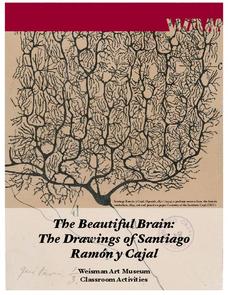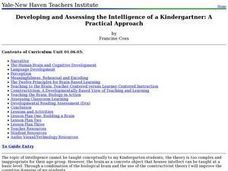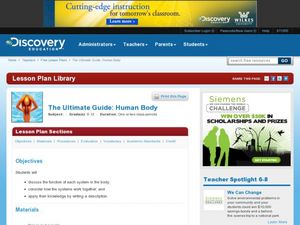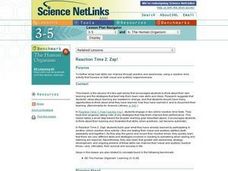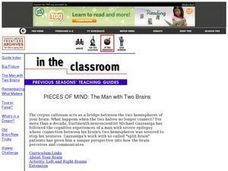Curated OER
Sheep Brain Dissection
Students study the brain and examine what the functions of the major functions are. In this investigative lesson students dissect a sheep's brain and note the similarities and differences between it and a humans brain.
University of Minnesota
Beautiful Brain: Step Inside the Brain
Before digital microscopes, scientists hired artists to draw the things visible in the microscope. Through training in neuroscience and art, Cajal revolutionized the way we view the beautiful brain. The third lesson in a series of four...
University of Minnesota
Beautiful Brain: Do You See What I See?
Can art play tricks on your eyes, and can a still painting really appear to vibrate? The second lesson plan in a four-part series discusses the way our beautiful brains translate visual images. It highlights the style of optical art and...
University of Minnesota
Beautiful Brain: Strangest Dream
Do words change or add meaning or interest to a work of art? The final lesson in a four-part series on the beautiful brain as a work of art focuses on art analysis. Scholars write a story about exploring art from the inside. Reflections...
University of Minnesota
Dendritic Spines Lab
This is your brain on drugs ... literally! Your neuroscientists-in-training examine the evidence of drug use on the human brain and how neurons change their connectivity when altered by drugs. They then work together to create testing...
Curated OER
Studying Fossils
Students compare and contrast key skeletal differences between chimpanzees and humans: brain size, teeth, hand and thumb, trunk, pelvis, lower limb, foot and big toe. They then sort and group a set of mixed "fossil bones" of chimpanzee...
Curated OER
AP: Chapter 48: Nervous System
Human anatomy enthusiasts trace neurological pahtways in word and on a diagram, describe action potential of a nerve impulse, and identify the organs in the nervous system. Provide this to your biology class as a review before...
Science Teachers
Organ Systems Crossword Puzzle
An attractive and informative body systems crossword plus its answer key is provided for your life science learners. The topic is the organs. With 23 prompts to address, they are sure to get a complete review in identifying the systems...
Curated OER
Bones Provide Great Support!
How do bones help people move around? A science investigation prompts kids to draw arrows to certain bones that protect their organs. After they finish, they trace their hands on a piece of paper and trace the way their bones go. Great...
Curated OER
Developing and Assessing the Intelligence of a Kindergartner: A Practical Approach
Students name objects that are the same size, shape, and weight as the human brain. They touch the model brain, feeling the folds, etc. They make connections to the chart displaying the brain-like objects. They touch the 'potato flake'...
Curated OER
Anatomy of the Brain
Students explore human anatomy by completing a quiz. For this brain lesson, students read assigned text which discusses the different elements of the human brain and how they are used in everyday experiences. Students answer a multiple...
Curated OER
Brain and Senses
Students investigate the brain through multiple senses. In this biology lesson, students experiment with different activities involving taste, memory, touch, and sight to understand how the brain works. Students work in partners and...
Curated OER
Exploring the Left and Right Sides of the Brain
Explore the Human brain. Students become familiar with the left and right hemispheres of the human brain and engage in activities that activate powers that are dominant in each hemisphere.
PBS
Color Code
Don't let your brain play tricks on you! Learners test brain reaction rates while it is receiving multiple stimuli. They time each other reading a set of color words written in different colors and again when they are written in black....
Curated OER
Human Cloning, Genetic Engineering and Privacy
Review the aspects of human cloning and the moral issues associated with it. Individually, your students will keep a list of the articles related to this issue and research issues related to the ethic issues people are concerned with....
Discovery Education
Our Brain and Body on Opioids
Use a presentation that explores the world of prescription opioids. Learners look at the way the brain responds to the drugs and the long terms effects opioids have on the brain and body. At the end of the lesson, groups create a social...
Curated OER
Brain Awareness Week
Students explore human anatomy by completing a list of activities over five days. In this brain science lessons, students examine images of brains and identify the different parts. Students complete an in-class quiz regarding brain...
Curated OER
Mind Over Matter: How Does the Brain Work
High schoolers research previous attempts by scientists to discover the ways in which the brain works, design and conduct an experiment to illustrate current research and present their findings to the class.
Curated OER
The Ultimate Guide: Human Body
High schoolers study the body systems and their functions. For this human body lesson students research the Internet on body systems and write a description of them.
Curated OER
Reaction Time 2: Zap!
Learners explore critical thinking by conducting a reaction time experiment. In this human brain lesson, students utilize a timed Internet worksheet activity to research how fast their brain works when answering questions. Learners share...
Curated OER
Brain Manipulative Model
Students visualize the major human brain divisions by using a manipulative puzzle to discover the names and functions of the regions. They use this hands-on anatomy aid to study the braqin regions.
Curated OER
Brain Death
In this biology activity, students find the words that are associated with the concept of brain death and the answers are found at the bottom of the page.
Curated OER
The Brain: What's Going on in There?
Students examine images of human brains that illustrate that specific regions of the brain regulate specific functions. They extend that knowledge to examine how drugs of abuse activate an area of the brain called the reward system.
Curated OER
Left and Right Brains
Learners research the part of the brain known as the corpus callosum. The part of the brain that connects the left and right brain, students investigate its functions and how data passes from one side to another.





